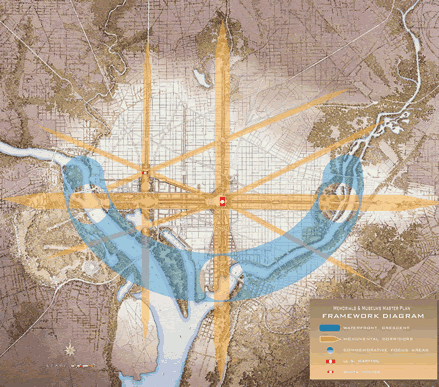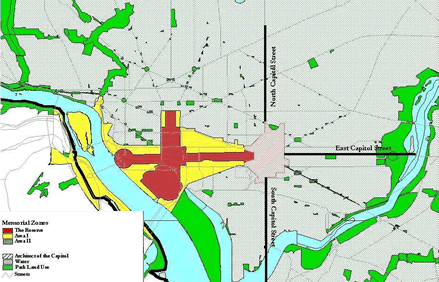
In the National Capital Area
Plan preserves open space, identifies 100 sites for future development

Associate Editor
The review agencies responsible for public land and federal commemorative policies have designed a new framework to guide development of future museums and memorials in Washington, D.C., and its surrounding jurisdictions in Maryland and Virginia.
The Joint Task Force on Memorials, an interagency group composed of the National Capital Planning Commission (NCPC), the Commission of Fine Arts, and the National Capital Memorial Commission, issued the "Memorials and Museums Master Plan" in September. The plan identifies 100 potential sites for future memorials and museums and provides general guidelines for their development.
It specifically promotes the development of these sites outside the "Monumental Core," which "many people believe . . . may soon surpass its capacity to accommodate these activities," according to the report.

The master plan establishes a "reserve in the central portion of the Monumental Core in which no new memorial sites will be permitted," according to the report. The reserve "encompasses the central cross axis of the National Mall formed by its primary resources-the U.S. Capitol, Lincoln Memorial, White House, Washington Memorial, and Jefferson Memorial." The plan is based on the designation of zones as described in the Commemorative Works Act of 1996. Area I is the close-in portion of the capital where commemorative works of "preeminent historical and lasting significance" may be located. Area II, further from the core, is where works of "lasting historical significance" may be placed.
As of June 2001, there were 155 memorials and 74 museums on public land in the District of Columbia and environs.
Beyond the Mall
Denise Liebowitz, public information office at the NCPC, said the task
force looked to place memorials "beyond the traditional areas."
She said once the group decided to limit development on the National Mall,
it asked, "If not there, then where?"
The answer resulted in the development of a plan that authorities say will help "balance the desires of sponsors to be in the heart of the city with the need to protect the beauty and openness of the Mall."
The task force put into practice a process to develop consensus on the 100 potential sites that may be used for a major memorials or museums and to evaluate they type of use that would be appropriate for the specific area. In presenting the plan for approval, NCPC project manager Ron Wilson summarized site evaluation concerns, including size, location, transit connections, cultural and historic resources, and the possible economic benefits of each site. "With this information in hand, sponsors and review agencies will be able to discern quickly whether or not a particular project is suitable for a particular location," the report noted.
Building on L'Enfant's
vision
The plan builds upon Pierre L'Enfant's vision and design for the nation's
capital, taking into account both the McMillan Plan of 1902, which grouped
together public buildings organized around governmental activities, and
the NCPC's 1997 vision plan, Extending
the Legacy: Planning America's Capital for the 21st Century.

Architecture firm Leo A Daly, Washington, D.C., served as the lead consultants on the project and worked with a series of other firms including EDAW; Economic Research Associates, Inc.; and Gorove Slade, all of Alexandria, Va.
Michael Winstanley, AIA, Leo Daly's director of design and project director for the museums and memorials work said the architects were "intrigued by looking at L'Enfant's original vision of Washington."
Winstanley said the firm—in consultation with the task force; an expert panel that included David Childs, FAIA, Michael Graves, FAIA, and Witold Rybczynski, FAIA; and others—created an urban design framework based on the development of the capital's waterfront areas, specifically, the Potomac and Anacostia Crescent. He said the planners hope to link all memorials by water-based transportation, which is generally more efficient and environmentally sound than other forms of travel. The plan envisions interpretive work on the water and drop-off points at different areas along the waterfront that would ultimately lead to people moving up toward the U.S. Capitol in the Monumental Core, Winstanley explained.
Rod Mercer, ASLA, project manager for the Daly team added that, "the Master Plan has evolved into an extremely practical resource for potential memorial sponsors as well as federal agencies responsible for new commemorative features in Washington. It was not only presented to the agencies involved but was also tested through an extensive public review process that addressed local community as well as national concerns," said Mercer.
A tool to share
The monuments master plan helps give the different agencies, which include
the General Services Administration and the National Park Service a common
planning tool and menu that helps guide sponsors through the site selection
process.
Officials at the National Park Service are very supportive of the plan. "We could not be more wildly enthusiastic," said Sally Blumenthal, deputy director of the National Capital Region office of the National Park Service.
Liebowitz at the NCPC agrees. This makes the selection and development of memorials more "accessible, available, . . . and transparent," she said.
Copyright 2001 The American Institute of Architects. All rights reserved.
![]()
|
The Memorials and Museums Master Plan and information about its development are available at the NCPC Web site. Images courtesy of Leo A. Daly. Left: The framework for the Master Plan emphasizes the development of a Waterfront Crescent along the Potomac and Anacostia rivers. The crescents would be complemented by "Monumental Corridors" that, according to the Task Force, "provide important visual and symbolic connections to the Capitol, the White House, and other landmarks." Below: Based on the recommendations of the Joint Task Force on Memorials, NCPC, the Commission of Fine Arts, and the National Capital Memorial Commission each adopted a Commemorative Zone Policy in January 2000. The intent is to encourage memorials to locate in all quadrants of the city. The new policy affects only new memorial proposals, not those that already have received approval by the respective approval bodies. |
|